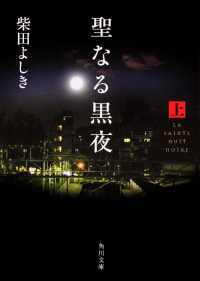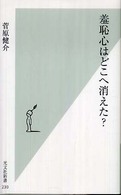- ホーム
- > 洋書
- > 英文書
- > Religion / Ethics
Full Description
This standard text explores religion in Japan as a complex tapestry of different religious strands, reflecting both the unity and diversity of Japanese culture, a theme Earhart pioneered in the first edition (1969) of this enduring, classic book--a theme he has devoted subsequent decades to refining through cutting-edge scholarship and keen observation of the evolving religious scene. Tracing the development of religious traditions from the prehistoric era through modern times, Earhart explores the vital influence of Shinto, Buddhism, Daoism, Confucianism, and folk religion. Presuming no technical or academic background, the text guides students to key Japanese religious themes, which include the proximity of humans and gods, the religious character of the family, the bond between religion and the nation, and the pervasiveness of religion in everyday life. This new edition updates the description and interpretation of the entire history of religion in Japan in light of the latest developments in the field. In the latter chapters, changes in the contemporary scene are highlighted, discussing Tokyo Disneyland, manga, and anime as "alternative reality," as well as the innovations in more "traditional" events such as wedding ceremonies and rites for the dead.
Contents
1. Introduction.
Five Major Religious Strands. Unity and Diversity.
2. Persistent Themes in Japanese Religious History.
The Closeness of Human Beings, Gods, and Nature. The Religious Character of the Family. The Importance of Purification, Specific Rituals, and Amulets. The Prominence of Local Festivals and Individual Cults. The Pervasiveness of Religion in Everyday Life. The Intimate Bond Between Religion and the Nation. The Traditional Worldview.
PART I: The Formation of Religion in Japan.
3. The Prehistoric Heritage.
The Beginnings of Japanese Culture. The Evidence for the Earliest Religion in Japan. Dealing with the Dead: Burial, Jars, and Tombs. Fertility: Rice and Figurines. Kami from Heaven and Female Shamans.
4. The Kami Tradition.
The Early Kami Tradition in Japan. Tradition and Religion in Cross-Cultural Perspective—
Tradition as Illusion. Features of the Kami Tradition: Sacred Spaces. The Mythological Tradition: Yin, Yang, Yamato Rulers, and Tension Between Kami and Buddhas. The Ritual Tradition: Enthronement, Purification, Festivals, and Divinations.
5. Early Buddhism in Japan: Indian, Chinese, and Korean Influence.
Buddhism: The Doctrine Most Excellent Enters Japan. The Power of Buddhism: Protection, Healing, and Rites for the Dead. The First Nuns and Monks in Japan. The First Buddhist Temples in Japan. Indian Buddhism in Japan. Popular Preaching: Dharma, Karma, and Miraculous Stories. State Buddhism and Popular Buddhism.
6. Daoism and Confucianism: Chinese Importations.
Two Chinese "Ways". The "Way" of Daoism and the Chinese Worldview. Daoism and Daoist Influence in Japan. The Bureau of Yin and Yang. The "Way" of Confucianism and Japan: Shotoku's "Constitution". Confucian Influence: A "University" and Worship of Confucius. Confucianism and Japanese Society. Daoism and Confucianism as Japanese Traditions.
7. Folk Religion: Beliefs and Practices Outside Organized Religion.
The Little Tradition and the Great Tradition. The God of the Everlasting World. Wizards, Shamans, Sacred Mountains, Magic, and Divination. The Sound of Silence and Buddhist Clothing. Folk, Tradition, and Religion.
8. Interaction in Early Religion in Japan.
A Multipolar System. Religion in Japan as a Tree. The Formation of a Distinctively Japanese Religious Heritage.
PART II: The Development and Elaboration of Religion in Japan.
9. The Development of a Japanese Buddhism: Shingon and Tendai. The New Buddhism of the Heian Period. Shingon: Esoteric Buddhism in Japan, Ritual over Philosophy, and Enlightenment in This Body. Kukai and Esoteric Buddhism. Mantras, Mandalas, and Goma (Fire Rite). Tendai: The Lotus Sutra, Proper Ordination for Monks, and Buddhahood for All Humans. Saicho and Tiantai. Mahayana and the Lotus Sutra. Buddhahood for All Humans, and Esoteric Rites. The Development of Japanese Buddhism, and Religious Trends.
10. The Shrine Tradition, and Shugendo.
The Kasuga-Kofukuji Shrine-Temple Complex. Ise Shrine: Purity, Ritual, and Taboos. Shugendo: Mountain Ascetics and Religion for the People. The Kami Tradition and the Shrine Tradition.
11. Elaboration Within Japanese Buddhism: Pure Land, Nichiren, and Zen Buddhism.
Buddhism: From Heian to Kamakura Times. The Pure Land Sects: Faith in Amida and the Recitation of the Nenbutsu.. Nichiren: Faith in the Lotus Sutra as the Exclusive National Buddhism. The Zen Sects: Enlightenment Through Meditation. Dogen: Sitting in Meditation. Zen: Institutional and Artistic Developments.
12. From Kami and Shrine Tradition to Shinto.
Kami Secondary to Buddhas. Buddhas Secondary to Kami. Yoshida Kanetomo: Shinto as the Essence of Japan. Shinto Shrines, Buddhist Temples, and Multiplexes.
13. The Appearance of Christianity in Japan.
The Introduction of Christianity into Japan. The Acceptance of Christianity in Japan. The Expulsion of Christianity. The Significance of the Christian Century.
14. The Five Traditions: Development and Mutual Influence.
PART IIII: Continuity and Discontinuity in Japanese Religions.
15. Buddhism, Neo-Confucianism, and Shinto in the Tokugawa Period.
The Tokugawa Anti-Christianity Policy and Funerary Buddhism. The Tokugawa Government and Religion. Tokugawa Buddhism: Decadence or Vitality. Neo-Confucianism: Political Stability and Social Conformity. Neo-Confucianism: The Development of Public and Private Ethics. Restoration Shinto: The Movement for a Purified Shinto. Motoori Norinaga and Restoration Shinto.
16. The Meiji Restoration and State Shinto.
The Political and Religious Significance of the Meiji Restoration. The Attempt to Purify and Restore Shinto. The Establishment of Nonreligious Shrine Shinto. Japan as a Nation-State—Nationalism in World Perspective. State Shinto as an Expression of Nationalism and Militarism. Shinto After World War II.
17. Religious Currents from 1868 to 1945.
Meiji Buddhism: "Outside Criticism"and "Inside Criticism". Christianity: Strengths and Weaknesses Since 1868. The New Religions: New Variations from Old Traditions. The Fortunes of Religion 1868-1945: From Freedom of Religion to State Orthodoxy.
18. Three New Religions: Tenrikyo, Soka Gakkai, and Aum Shinrikyo.
The Many New Religions: Differences and Similarities. Tenrikyo: A Living Kami and a Joyous Life. Soka Gakkai: Faith in the Lotus Sutra and a Happy Life. Aum Shinrikyo: The Marriage of Religion to Violence. The Significance of the New Religions.
19. Religion in Postwar Japan.
Shinto: Disestablishment, National Reorganization, and Local Participation. Buddhism: From Degeneration to Regeneration. Christianity: The Problems of Denominationalism. The Postwar Boom of New Religions.
20. Religious Life in Contemporary Japan.
Characterizing Religious Life in Japan. Persistent Themes in Contemporary Japanese Religious Life. Approaches to Religious Change. Transformations of Religious Life in Contemporary Japan. Modalities of Alternative Reality in Contemporary Japan. 1984 and 1Q84.
21. Conclusion: The Challenge for Religion in Japan.
Annotated Bibliography on Religion in Japan.
Index.








